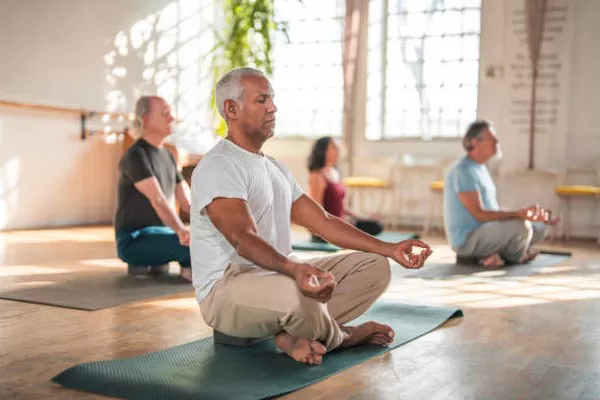Vinyasa yoga, known for its flowing movements and synchrony with breath, is a popular choice among yoga enthusiasts. But is it suitable for beginners? This article explores Vinyasa yoga, its benefits, challenges, and provides practical advice for those new to the practice.
What is Vinyasa Yoga?
Vinyasa yoga, often referred to as “flow” yoga, involves a series of poses that seamlessly transition from one to another. This style emphasizes breath synchronization with movement, creating a dynamic and fluid practice.
Benefits of Vinyasa Yoga for Beginners
Physical Benefits
Strength Building: Vinyasa yoga strengthens muscles through various poses, supporting overall body conditioning.
Flexibility: Regular practice enhances flexibility, reducing the risk of injuries.
Balance and Coordination: It improves balance and coordination, essential for overall physical fitness.
Mental Benefits
Stress Reduction: The focus on breath and movement helps alleviate stress and anxiety.
Mindfulness: Vinyasa yoga promotes mindfulness, encouraging a present-moment awareness.
Improved Focus: The practice enhances concentration and mental clarity.
Challenges of Vinyasa Yoga for Beginners
Physical Challenges
Intensity: Vinyasa can be intense, which might be challenging for those new to physical activity.
Pace: The fast pace may be overwhelming, making it difficult to keep up.
Flexibility Requirements: Some poses require a certain level of flexibility, which beginners might lack.
Mental Challenges
Concentration: Maintaining focus on breath and movement simultaneously can be challenging.
Patience: Progress can be slow, requiring patience and persistence.
Tips for Beginners
Start Slow
Begin with Basics: Start with basic poses and gradually progress to more advanced ones.
Short Sessions: Begin with shorter sessions to build stamina and familiarity with the practice.
Focus on Breath
Breath Awareness: Focus on synchronizing breath with movement to create a flow.
Controlled Breathing: Practice controlled breathing techniques to enhance the experience.
Seek Guidance
Find a Qualified Instructor: A good instructor can provide guidance, correct alignment, and modifications for poses.
Attend Beginner Classes: Look for classes specifically designed for beginners to ensure a comfortable learning pace.
Use Props
Yoga Blocks and Straps: Use props to assist with poses and improve alignment.
Blankets and Bolsters: These can provide support and comfort during practice.
Listen to Your Body
Avoid Overexertion: Respect your body’s limits to prevent injuries.
Rest When Needed: Take breaks when necessary and don’t push too hard.
See Also: Best Vinyasa Flow Sequence
Basic Vinyasa Yoga Poses for Beginners
Mountain Pose (Tadasana)
Instructions: Stand with feet together, arms at sides. Inhale, lift arms overhead, and reach toward the sky.
Benefits: Improves posture and balance.
Downward-Facing Dog (Adho Mukha Svanasana)
Instructions: From hands and knees, lift hips, forming an inverted V-shape. Keep arms and legs straight.
Benefits: Stretches the back, hamstrings, and calves.
Plank Pose (Phalakasana)
Instructions: From Downward Dog, shift forward into a plank position with shoulders over wrists.
Benefits: Strengthens the core, arms, and shoulders.
Cobra Pose (Bhujangasana)
Instructions: Lie on your stomach, place hands under shoulders, and lift chest while keeping elbows bent.
Benefits: Strengthens the back and stretches the chest and shoulders.
Child’s Pose (Balasana)
Instructions: Sit on your heels, fold forward, and extend arms in front. Rest forehead on the mat.
Benefits: Provides a gentle stretch and relaxation.
Creating a Beginner Vinyasa Yoga Routine
Warm-Up
Gentle Stretches: Start with gentle stretches to prepare the body.
Breathing Exercises: Practice deep breathing to center yourself.
Flow Sequence
Sun Salutations: Incorporate Sun Salutations to build heat and connect breath with movement.
Standing Poses: Include poses like Warrior I and II for strength and balance.
Seated Poses: Add seated poses like Seated Forward Bend for flexibility.
Cool Down
Gentle Twists: Include gentle twists to release tension.
Relaxation: End with a relaxation pose like Savasana to integrate the practice.
Incorporating Vinyasa Yoga into Your Routine
Consistency
Regular Practice: Aim for regular practice to see progress and benefits.
Shorter Sessions: Start with shorter sessions and gradually increase duration.
Balance with Other Activities
Cross-Training: Balance yoga with other forms of exercise like strength training or cardio.
Rest Days: Incorporate rest days to allow the body to recover.
Conclusion
Vinyasa yoga can be an excellent practice for beginners, offering numerous physical and mental benefits. By starting slow, focusing on breath, seeking guidance, using props, and listening to your body, beginners can safely and effectively incorporate Vinyasa yoga into their routine. Embrace the journey, and enjoy the flow!


